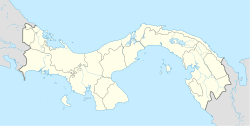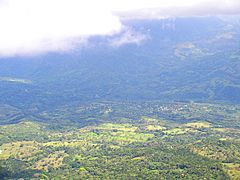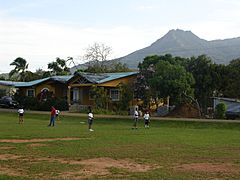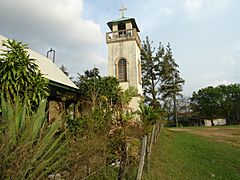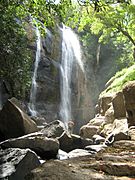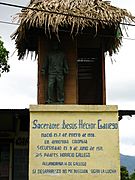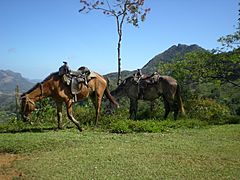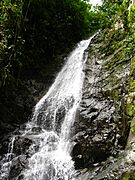Santa Fe, Veraguas facts for kids
Quick facts for kids
Santa Fe de Veraguas
|
|
|---|---|
|
Town
|
|
| Country | |
| Province | Veraguas |
| Founded | ~ 1560 |
| Area | |
| • Land | 145.1 km2 (56.0 sq mi) |
| Elevation | 430 m (1,410 ft) |
| Population
(2010)
|
|
| • Total | 3,047 |
| • Density | 21/km2 (50/sq mi) |
| Population density calculated based on land area. | |
| Time zone | UTC−5 (EST) |
| Climate | Am |
Santa Fe is a small town in the Veraguas Province of Panama. It is the main town of the Santa Fe District. About 3,200 people live there, and it is located about 430 meters (1,410 feet) above sea level.
Santa Fe is near the continental divide, which is a ridge of mountains that separates rivers flowing to different oceans. It is only about 60 kilometers (37 miles) from the Mosquito Coast on the Caribbean Sea. However, the town is mainly connected by a paved road to the Pacific coast. This road leads to the Pan-American Highway and the city of Santiago de Veraguas.
The area around Santa Fe is famous for its beautiful natural environment. The Santa Fe National Park surrounds the town on three sides. This park is very large, covering about 72,636 hectares (179,500 acres). It is home to many different kinds of plants and animals.
- Over 300 types of birds live in the park.
- You can find more than 300 types of orchids there.
- The park also has rare plants and animals.
The Santa Maria River and its smaller streams start in the park. The clean air and thick forests make Santa Fe a popular place for tourists. People enjoy outdoor activities like hiking and watching birds in this area.
Contents
History of Santa Fe
After the Spanish arrived in the Americas, the area that is now Veraguas Province was given to Luís, the grandson of Christopher Columbus. He tried several times to take control of the native people living there. When his efforts did not work, he sold his rights back to the Spanish crown.
The Spanish crown then created the Province of Veragua. In 1560, a Spanish captain named Francisco Vázquez became its first governor. Santa Fe was founded around this time. Its main purpose was to mine for gold.
Early Days and Isolation
Not much is known about Santa Fe's very early history. The town remained quite isolated for a long time, until the 1950s. During this period, a few powerful families controlled most of the resources in the valley. It was very hard to travel to the larger town of Santiago for most of the year because there were no paved roads.
Changes and Community Building
Things began to change in 1967 when a Catholic priest named Jesús Héctor Gallego Herrera arrived from Colombia. Father Gallego started to help the local farmers organize themselves into cooperatives. Cooperatives are groups where people work together and share resources. This helped the farmers avoid the control of the powerful families in town.
By 1971, Father Gallego's movement had grown very popular, even outside Santa Fe. The country's leader at the time, Omar Torrijos, saw Father Gallego as a challenge. With help from one of the local families, Father Gallego was arrested one night and was never seen again.
However, Santa Fe finally got a paved road connecting it to other areas in 1971. The cooperative that Father Héctor Gallego started is still active today.
Gallery
See also
 In Spanish: Santa Fe (Veraguas) para niños
In Spanish: Santa Fe (Veraguas) para niños


